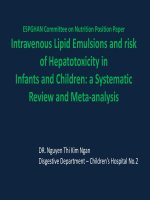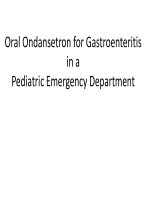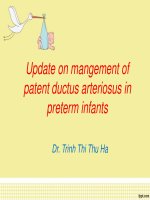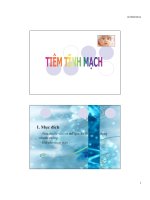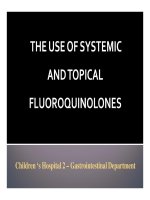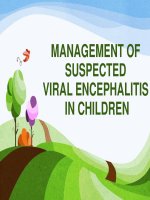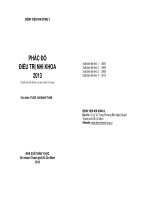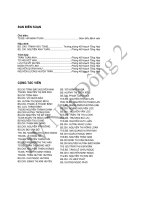The Use Of Systemic And Topical Fluoroquinolones | Website Bệnh viện nhi đồng 2 - www.benhviennhi.org.vn
Bạn đang xem bản rút gọn của tài liệu. Xem và tải ngay bản đầy đủ của tài liệu tại đây (767.75 KB, 15 trang )
Children ‘s Hospital 2 – Gastrointestinal Department
OVERVIEW
HISTORY
Fluoroquinolones are highly active in vitro against both
Gram (-) and Gram (+) pathogens and have
pharmacokinetic properties that are favorable for treating
a wide array of infections
Drugs:
acid nalidixic, norfloxacin,
ofloxacin, levofloxacin, moxifloxacin
ciprofloxacin,
OVERVIEW
Generation
Drug Names
Spectrum
1st
Nalidixic acid
Gram (-) but not
Pseudomonas species
2nd
Norfloxacin
Ciprofloxacin
Enoxacin
Ofloxacin
Gram (-) (including
Pseudomonas species),
some Gram (+) (S. aureus)
and some atypicals
3rd
Levofloxacin
Sparfloxacin
Gemifloxacin
Same as 2nd generation
with extended Gram (+)
and atypical coverage
Moxifloxacin
Same as 3rd generation
with broad anaerobic
coverage
4th
OVERVIEW
HISTORY
Nalidixic acid:
First generation approved by the FDA
≥ 3 months
Ciprofloxacin:
Second generation used in children (2004)
1 - 17 years of age.
OVERVIEW
In 2006, according to the American Academy of
Pediatrics:
Parenteral
fluoroquinolones:
multidrug - resistant pathogens
appropriate
for
Oral fluoroquinolones: for outpatient management,
when other options were intravenous antibiotics
SAFETY
RCT of Bayer:
684 children from 1 – 17 years old
Compared:
(1)
intravenous
ceftazidime
with
intravenous ciprofloxacin (2) oral ciprofloxacin with
oral cefixime or TMP - SMX.
No
difference
to
suggest
musculoskeletal toxicity with ciprofloxacin
potential
SAFETY
A large cohort of Johnson & Johnson:
2523 children in 5 years
Community acquired Pneumonia: 6 months - 16 years
Acute otitis media: 6 months - 5 years
No change in height percentile; improvement or
deterioration in growth of levofloxacin group
SAFETY
WHO:
There is no definite evidence to show that they
induce sustained injury to developing joints in
children.
Quinolone is safe and effective in children.
USE OF QUINOLONE IN PEDIATRICS
• Conjunctivitis
• External Otitis
• Acute Otitis Media, Sinusitis
• Lower Respiratory Tract Infections
• Gastrointestinal Infections
• Urinary Tract Infection
• Mycobacterial Infections
USE OF QUINOLONE IN PEDIATRICS
GASTROINTESTINAL INFECTION
Shigellosis:
Ampicillin and TMP - SMX resistance is increasing
RCT in 201 children compared ciprofloxacin with
Ceftriaxone
equivalent between 2 groups
Multi – center RCT in VN: ciprofloxacin and
gatifloxacin are similarly effective for the treatment of
acute shigellosis.
GASTROINTESTINAL INFECTION
Campylobacter :
Resistance rates are increasing in many parts of the
world
In Taiwan, Thailand and Sweden rates of 57%, 84%,
and up to 88%
GASTROINTESTINAL INFECTION
Gram (-) neonatal sepsis:
116 neonates with sepsis were treated successfully
with ciprofloxacin.
No adverse events were observed
used for treating Gram (-) sepsis in neonatal
H. PYLORI INFECTION
Adult patients: levofloxacin in 2nd line triple therapy
Children:
2007:
o 110 patients from 6 - 18 years
o 16.4% failed to respond to the triple and then
quadruple regimen was successful with LML
(Levofloxacin + Metronidazole + Lanzoprazole)
2011 NASPGHAN & ESPGHAN: PPI + Levofloxacin
(Moxifloxacin) + Amoxicillin (2nd line or salvage
therapy)
THANKS FOR ATTENTION
